Our trip to Inner Mongolia was an interesting adventure. I had thought we were going by train, but somehow I missed the memo that we were taking the bus instead. It was okay though. When you take the bus you still get to see the country (though you are much more susceptible to traffic jams).
We pulled out the south gate of the university on Friday at 12:50pm, only twenty minutes behind schedule—not bad for a group of about 45 people from all over the world. I sat in the middle seat of the back row so that I could take advantage of the leg room in the aisle (Travel tip: while this is a good strategy for short trips, on a long trip it is better to sit by the window. You have a better view for taking pictures, and it is easier to sleep).
There were a few noteworthy things to see on the ride up. The first was the shocking numbers of large trucks on the highways. For mile after mile, lines of trucks crowded the highways. At every hill, slow-moving trucks backed up in both lanes and made passing difficult. I had never seen so many trucks before. When you drive on I-80 between Chicago and New York, you don’t see so many trucks. We saw trucks hauling steel, cranes, wind turbine blades and nacelles, livestock (cattle and sheep), cement, rice, etc. The most common type of truck on the road was carrying some type of cargo hidden under a tarp, so you couldn’t tell what it was hauling. Later, I figured out that they were carrying: large chunks of coal to the power plants and factories of Beijing and beyond. China’s economic growth is powered by enormous amounts of energy, much of which is produced from coal. It’s one of the main reasons that Beijing has such poor air quality.
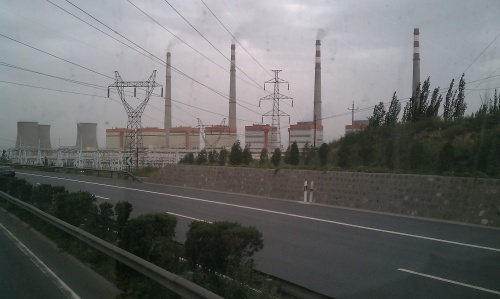 Fueling the dragon economy
Fueling the dragon economy
The second thing I enjoyed on the trip was watching the landscape change as we travelled towards our destination. Soon after we left Beijing, we traveled through some low, steep mountains, passing by a section of the Great Wall known as Baidaling. After the mountains, we entered a wide river valley with hills on either sides. There was a lot of corn and other crops being grown in small fields on either side of the road. Every so often we passed by a town with small brick houses and walled gardens. Leaving the valley, be began the ascent to the Mongolian highlands and soon the land opened up into rolling grassy hills that reminded me of the rangelands of western Kansas. Crops of wheat canola, millet and others grew in the beautiful fields.
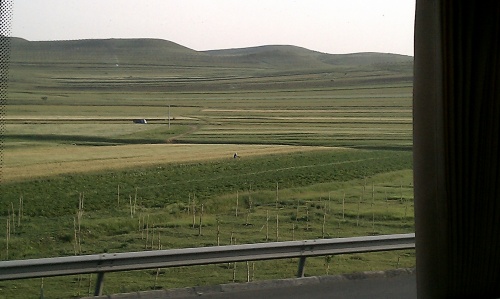
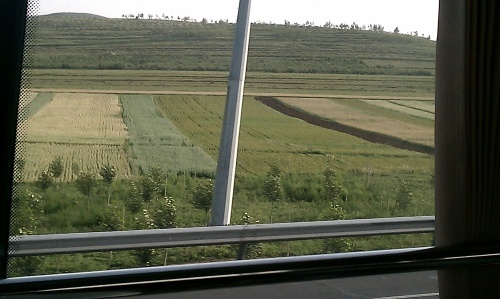 Lots of different crops
Lots of different crops
After a while, we turned right off of the main road and began the ascent to our final destination. You could sense the transmission heating up as the bus labored up the hill. A man walking a horse up the hill passed us on the right (not really, but we were going slow). At the top of the hill, we finally reached the high, grassy plain. We turned right into a long dirt driveway and passed through a decorative gate that was the only indication we were near our destination. After driving several miles down the road that was better suited for a Land Rover than for our tour bus, we were greeted by six men on horseback. They had ridden out to meet us in brightly colored costumes, bearing red flags on long poles. They turned and escorted our bus to the camp entrance.
As we got off the bus, we were greeted by a group of singing young women in multi- colored outfits. They welcomed each of us as we got off with a drink poured into a small steel cup, refilling it for each traveler from a decorative silver tea pot. It wasn’t tea that they were pouring, though. It was what I call ‘white fire’ (the Chinese call it baijiu (white liquor), but I don’t think that quite captures the essence of the drink). Welcome to Inner Mongolia!
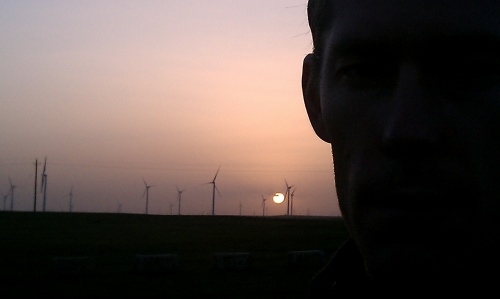 A beautiful sunset
A beautiful sunset
We gathered just beyond the parking area with a group of Chinese tourists who had also just arrived. Our hosts gave a very brief riding demonstration and then a demonstration of traditional Mongolian wrestling—full contact—with audience participation.
The Mongolian hosts first gave a demonstration of how to wrestle. They wore a heavy leather breastplate that protected their shoulders, back and upper chest. The gear looks like a set of low-tech American football shoulder pads. When the competition starts, each wrestler grabs the shoulders of the other with both hands. From there, the goal is to take the other person down. Using legs to trip your opponent is permitted (encouraged), and the competition hinges on who has the best combination of strength, balance and quickness.
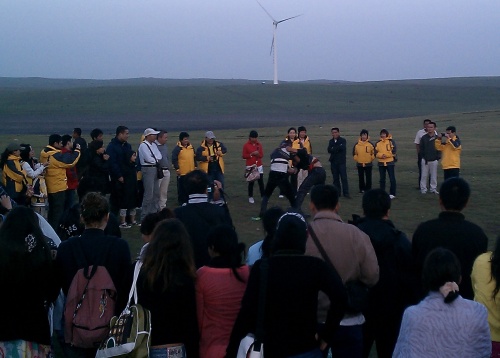 Welcome. . .
Welcome. . .
From our group, we had two participants. Luis, a Spaniard who is built similar to a bulldog, went first. He had wrestled some while spending a couple of his high school years in Michigan. His technique was good and he held strong for a while, but in the end his opponent was too quick, and Luis got slammed to the ground. He received a hero’s cheer from the crowd and a torn shirt for his efforts.
Our second combatant was a young Japanese guy. He was tall and looked strong. It turned out that he had a talent for Mongolian wrestling. The two men locked arms, ready for battle. Several times, the Mongolian opponent tried to use his feet to trip up our representative, but after a while BLCU’s finest used his strength and speed to flip his opponent over, landing on top of him to add an extra dose of punishment. We cheered wildly. The night was off to a good start. It was, as my PSU Chinese teacher might say, an ‘auspicious’ beginning.
One of the things about China that I like the most is that it is still a little wild, a little rough around the edges. They are not afraid to let you get hurt. The wrestling is a great example. Where else could a group of tourists show up and be treated to one of their own winning a full-contact sport for which he had not prepared?
Dinner came soon after we arrived and it was also an interesting experience. The main feature of the meal was roasted goat. The meat was not anything special—in fact, it was really tough—but the presentation was. The specially-dressed waiters wheeled out a whole roasted goat on a cart. The goat had been set upright with its forelegs in front, as if it were sitting in a field on its haunches. Our hosts treated us with a special ceremony (authentic, I’m sure), complete with singing, and a man cut out the first piece of meat from the goat’s neck. Waitresses were pouring white fire in another steel cup, much as they had when we arrived. For a minute I was worried that it was going to be like a sidrería in Spain, where waiters pour you small glasses of hard cider throughout your meal (the difference being, of course, that cider is 5% alcohol and the white fire 50%). Daniel (dan-YELL), beside me, was nervous. “Drinking this before we even get to eat is crazy,” he said, with good reason. Fortunately, they only brought us a couple of rounds before switching to tea. Our meal was fine but not great. It consisted of many small dishes to accompany the meat.
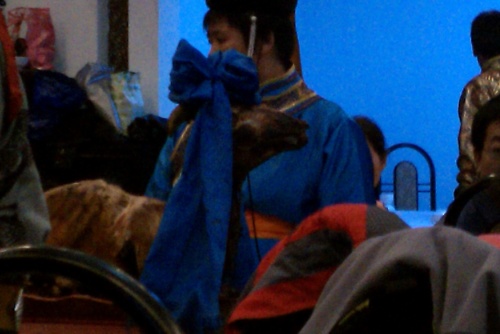 the main course
the main course
After the meal we went outside for the promised bonfire, folk songs and dancing. In front of the big lodge, in a round cement plaza, our hosts had set up a bonfire on a small iron stand. The fire was disappointing. We had expected a bonfire big enough to sit around, but we ended up with a fire that wasn’t much larger than your average backyard grill. Since it was cold and windy, there was a lot of competition to crowd around the fire. The wind kept picking up embers and blowing them across one side of the space. It was kind of a waste of a fire, so we had to dance to keep warm instead.
A little later, someone in our group decided that the second best way to keep warm would be to buy a bottle of baijiu. So while the people were singing and dancing, we were also passing around the bottle of something that tasted like cologne. There were enough people sharing the bottle that no one really felt any effects from it. Everyone was still cold.
At 10:40, the music finished. Ten minutes later, they shut the lights of, so we sat there in the dark and looked at the stars for a while. It was a clear night and you could easily see the Milky Way. By midnight, only eight of us remained outside—f our Spaniards, three Italians and me. We fought the wind for a while and eventually found temporary refuge behind the base of a large bronze statue of a bull. After a while, though, everyone was freezing so we ended up back in one of the yurts for another hour or so before crashing back sometime after 1am.
The yurts at the camp were individual round structures about ten feet in diameter and nine feet tall. From the outside, each one looked like a marshmallow with a round top. The whole structure is wrapped in a blanket-like insulated canvas that is impermeable to wind and water. A small, thin wooden door keeps most unwanted visitors out.
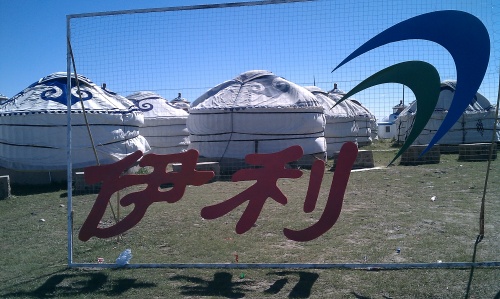 Yurts by the front gate
Yurts by the front gate
When you enter the yurt through the small door (watch your head!) you step onto a concrete slab. At the perimeter, the ceiling height is about five feet tall and it slopes inward and upward to about nine feet at the center. The walls of the yurt are formed by a lattice of bamboo, at the top of which, a bunch of small wooden poles lean inward and upward towards a ring in the center of the ceiling. You leave your shoes on the concrete before stepping up onto the sleeping area, which is not much more than a six-inch high wooden platform with a thin layer of foam padding on top. We slept with our heads toward the outside of the yurt dividing up the floor space as if it were the sections of a pizza. The bed was not especially comfortable (it was hard and lumpy) but it did provide a good refuge from the wind. It was cold enough, however, that we all slept under blankets with all our clothes and coats on.
After not sleeping well due to a variety of reasons, I awoke at 5:30 and couldn’t get back to sleep. Rather than sit there and be bored, I decided to go outside and watch the sun come up over the prairie. It was a beautiful day to do so.
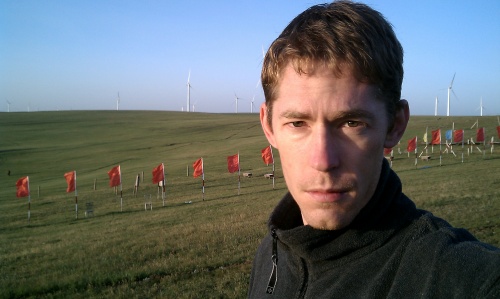
It would be difficult to overstate the vastness of the high plains of Inner Mongolia. The rolling hills stretch in all directions toward the horizon. There are few roads and no fences dividing the land. The thousands of wind turbines seem slightly out of place in the otherwise empty space.
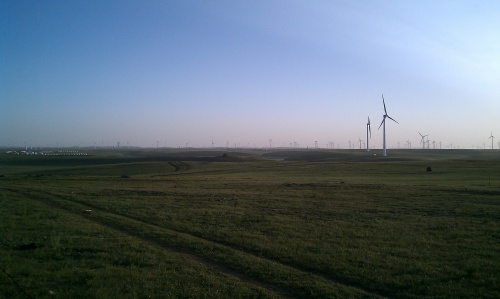 Vast
Vast
The wind and the grass and the rocks are the three things that make the prairie what it is. The wind is an ever-present companion. It blows from the west and from the north, chilling you even in the middle of August. The land is rocky, and the short green grass clings low against the ground to avoid the wind. It was beautiful to see the early morning sun illuminating the vivid green of the hills. I was in big country.
After breakfast, most of our group went out to ride horses on the grass. I stayed back at the camp because I had a bad cold and because I have an ingrained disinterest in horses that I inherited from my father. I sat on the bus, wrote a few things about the earlier part of the trip and took a short nap. It was a nice break.
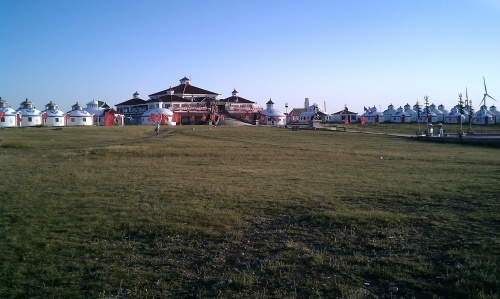 The camp and lodge
The camp and lodge
While I sat there, I watched the camp workers greet another group of tourists in the same manner that they had greeted us. I saw them put on their costumes and ride out to meet the bus, the women waiting at the camp, the kettle of baijiu ready to go. I wondered how many times they had prepared this performance for groups of nameless tourists. I wondered if they looked at what they were doing as a way of preserving the traditional Mongolian culture, or was it just some charade put on to impress the visitors who wouldn’t know any better. It didn’t seem like they really enjoyed the performances, but that could be just my misunderstanding of their expressions. I suppose that it produces enough income to allow them to live in their traditional homeland.
Overall, it was a nice place to visit. We escaped the city and got to see the blue skies, the white clouds and the grassy plains of the high prairie. There were some minor inconveniences (the cold, and the bathrooms, which were in the top five of the worst bathrooms I have ever seen in China), but I enjoyed the experience. If you ever have the opportunity to go, I’m confident that you will have a memorable trip. I know that I’ll always remember this one.